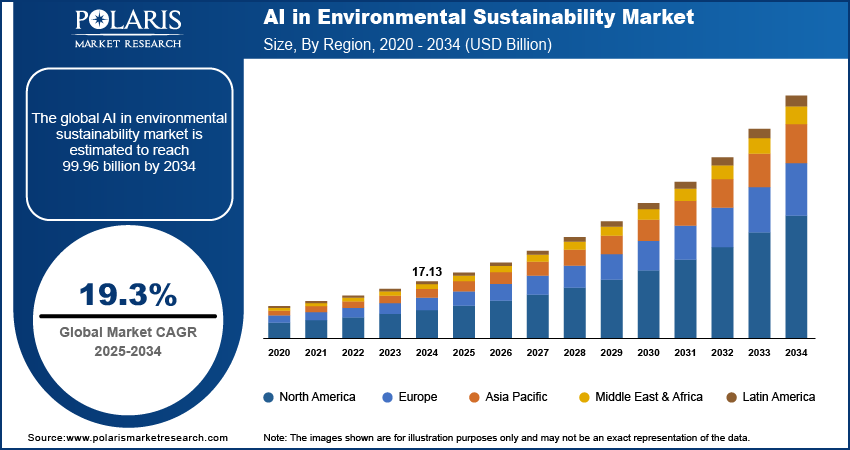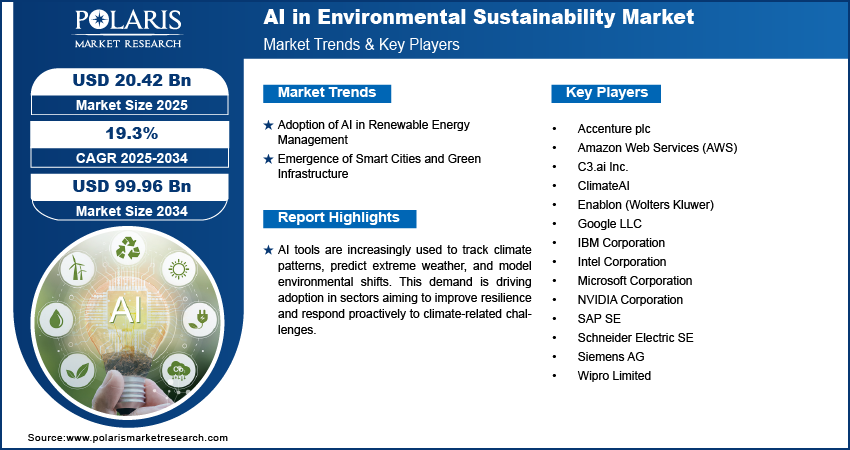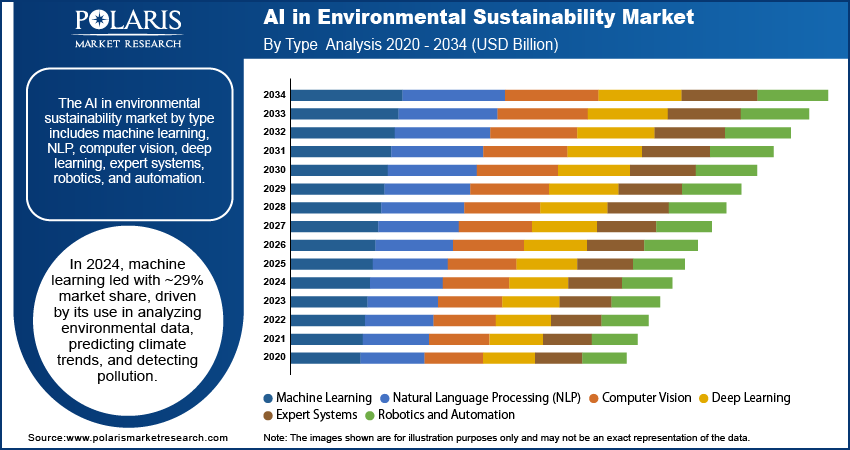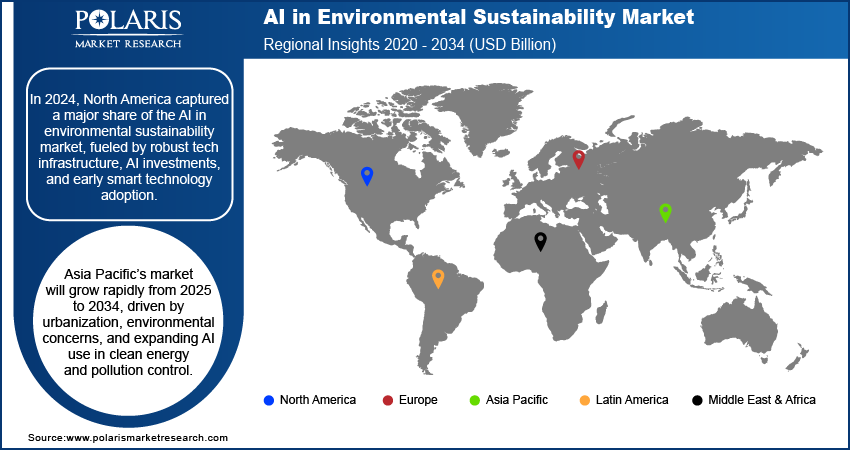
AI in Environmental Sustainability Market Size, Share, Trends, Industry Analysis Report
By Technology, By Application, By End User, and By Region – Market Forecast, 2025–2034
- Published Date:Sep-2025
- Pages: 129
- Format: PDF
- Report ID: PM6232
- Base Year: 2024
- Historical Data: 2020-2023
Overview
The global AI in environmental sustainability market size was valued at USD 17.07 billion in 2024, growing at a CAGR of 19.06% from 2025 to 2034. Key factors driving demand for AI in environmental sustainability include the increasing global energy demand and rising government regulations and policies.
Key Insights
- The machine learning segment dominated the market in 2024.
- The renewable energy optimization segment is expected to grow fast driven by requirements for energy efficiency, smart grids, and improved management of renewable energy.
- North America held the largest share of the global AI in environmental sustainability market in 2024.
- The U.S. market is growing due to big investments in clean energy, tech adoption, and supportive government policies.
- Asia Pacific is set to grow rapidly from 2025-2034, driven by industrialization, smart city projects, and sustainability programs.
- China and Japan are key contributors to regional growth due to AI advancements, strong renewable energy systems, and carbon neutrality goals.
Industry Dynamics
- Rising global energy demand is boosting the market by increasing the need for efficient energy use, lower emissions, and better renewable energy management.
- Stricter government regulations worldwide are driving AI adoption in environmental sustainability for emission control and climate targets.
- Integrating AI with carbon footprint tracking and emission monitoring is expected to create lucrative opportunities in future.
- High investments required in infrastructure, sensors, and data platforms may limit market growth.
Market Statistics
- 2024 Market Size: USD 17.07 Billion
- 2034 Projected Market Size: USD 97.60 Billion
- CAGR (2025–2034): 19.06%
- North America: Largest Market Share
AI for environmental sustainability utilizes intelligent algorithms and machine learning to monitor and manage environmental issues. Applications such as climate modeling and smart agriculture assist industries in reducing energy consumption, minimizing emissions, managing waste, and utilizing resources more efficiently. Governments and organizations are also embracing such tools to get closer to net-zero objectives.
Global climate policies are propelling the use of AI in this sector. Brazil, for example, is establishing a Climate Change Council led by the UN to be in charge of global efforts, with Germany seeking 65% less emissions by 2030 and net-zero by 2045. Such moves drive the demand for AI solutions used to track emissions, maximize the utilization of renewable energy and aid policymakers in delivering climate objectives.

Growing investments in clean energy and intelligent infrastructure are driving the market as private investors and governments invest in renewable initiatives and grid modernization. AI assists in enhancing energy efficiency, renewable integration management, and smart city planning to achieve environmental and economic advantages.
Drivers & Opportunities
Growing Global Energy Demand: Growing energy demand is fueling adoption of AI in environmental sustainability, as technologies maximize energy consumption, incorporate renewables, and reduce carbon emissions. According to the International Energy Agency, global electricity consumption rose from 629 TWh in 2024 to 1080 TWh, putting pressure on energy systems. Thus the growing global energy demand is making AI an essential tool for managing energy efficiently and reducing emissions while helping energy systems keep up with rising consumption.
Increasing Government Regulations: Rising government rules and green policies are speeding up the use of AI in environmental sustainability. Stricter standards on emissions, resource use, and renewable energy are boosting demand for AI tools that track, predict, and ensure compliance, helping industries meet climate goals and support decarbonization.

Segmental Insights
Technology Analysis
Based on technology, the market is divided into machine learning, computer vision, NLP, predictive analytics, and reinforcement learning. Machine learning dominated in 2024 as it analyzes vast environmental data sets, forecast climate trends and enhance energy systems. It is a dominant tool for sustainability projects due to its capability of dealing with big data and offering valuable insights.
The reinforcement learning segment is anticipated to grow significantly by 2034 as it enables making more informed decisions in intricate environmental systems. Its ability to adjust in real time to changing conditions makes it very useful for managing resources sustainably, and its use in energy, agriculture, and logistics is driving strong market growth.
Application Analysis
By application, the market is segmented into climate change mitigation, renewable energy optimization, waste management, biodiversity & wildlife monitoring and others. Climate change mitigation segment led the market as AI enables emission monitoring, enhances climate models and low emission strategies. Growing emphasis on net zero goals and global climate agreements is also driving its adoption.
The renewable energy optimization segment is set to grow fastest as AI enhances the efficiency and dependability of green energy systems. For example, in August of 2025, Dubai Electricity and Water Authority and Microsoft UAE collaborated to employ AI and smart grids technology with the aim of making DEWA the world's first AI-powered utility. The growing renewable infrastructure and increasing investments are fueling robust opportunities for AI implementation.
End User Analysis
By end user, the industry is divided into government & public sector, energy & utilities, agriculture, transportation & logistics, and manufacturing. The government and public sector accounted for the maximum share in 2024, considering that AI is highly adopted to monitor the environment, plan policy, and manage climate risk. Significant investments in digital solutions and partnerships with private entities are accelerating AI adoption and enabling sustainability ambitions.
The energy and utilities segment is anticipated to expand the most until 2034 due to rising adoption of AI to handle renewable energy, grid optimization and emission reduction. Increased spending on smart grids and transition to clean energy is fuelling growth.

Regional Analysis
North America dominated the AI in environmental sustainability industry in 2024 owing to massive investments in digital technology, aggressive government climate policies and business sustainability initiatives. The region benefits from advanced AI use in energy efficiency and renewable monitoring across industries and cities.
U.S. AI in Environmental Sustainability Market Insights
Government sustainability goals and carbon-neutral targets are driving AI use in environmental sustainability by improving energy efficiency, cutting emissions, and using clean technologies. The U.S. Department of State indicates that the US clean energy plan aims for 100% clean electricity by 2030, zero-emission cars and trucks by 2035 and net-zero emissions by 2050. These initiatives place a focus on AI as an essential solution in helping the U.S. in meeting its long-term clean energy and climate ambitions.
Europe AI in Environmental Sustainability Market Assessments
Europe is expected to hold a significant share of the market due to strict environmental standards and European Green Deal priority. Also initiatives on carbon monitoring, biodiversity and energy transition are speeding AI adoption in government and private sectors.
Asia Pacific AI in Environmental Sustainability Market Trends
Asia Pacific is expected to grow fastest during the forecast period driven by industrial growth and increasing adoption of clean energy. Governments are using AI for the governance of air, water, and land. Partnerships with technology firms and raising the capacity of renewable energy are driving AI uptake towards sustainable development.
China AI in Environmental Sustainability Market Overview
Expansion of renewable energy projects is driving AI into environmental sustainability as software helps plan, monitor and optimize solar, wind and hydropower networks. International Energy Agency reports that China is set to hold around 60% of global renewable installations by 2030, nearly half of the world’s total capacity, up from one-third in 2010, which highlights the role of AI in the country’s energy transition.

Key Players & Competitive Analysis
The environmental sustainability AI market is competitive with big players like Microsoft, IBM, Google, Amazon Web Services, Salesforce, Oracle, SAP and Hitachi. These companies use AI for energy optimization, climate modeling and carbon tracking. Collaborations and new technology launches help them to enhance their capabilities and expand their sustainability offerings.
A few major companies operating in the AI in environmental sustainability industry include Microsoft Corporation, IBM Corporation, Google LLC, Amazon Web Services, Salesforce, Inc., Oracle Corporation, SAP SE, Hitachi, Ltd., Cisco Systems, Inc., NVIDIA Corporation, Schneider Electric, and Siemens AG.
Key Players
- Amazon Web Services
- Cisco Systems, Inc.
- Google LLC
- Hitachi, Ltd.
- IBM Corporation
- Microsoft Corporation
- NVIDIA Corporation
- Oracle Corporation
- SAP SE
- Salesforce, Inc.
- Schneider Electric
- Siemens AG
AI in Environmental Sustainability Industry Developments
May 2025: SAP launched new AI instruments to deal with sustainability information that enable firms to streamline reporting and feature carbon monitoring as part of daily business operations.
May 2025: Schneider Electric initiated an extended AI-powered program based on Agentic AI to reduce carbon footprint and incorporate sustainability while contributing to international climate objectives.
February 2025: Salesforce introduced the AI Energy Score that scores 166 AI models on energy consumption to enhance transparency and encourage use of more efficient, environmentally friendly alternatives.
AI in Environmental Sustainability Market Segmentation
By Technology Outlook (Revenue, USD Billion, 2020–2034)
- Machine Learning
- Computer Vision
- Natural Language Processing
- Predictive Analytics
- Reinforcement Learning
By Application Outlook (Revenue, USD Billion, 2020–2034)
- Climate Change Mitigation
- Renewable Energy Optimization
- Waste Management
- Biodiversity & Wildlife Monitoring
- Others
By End User Outlook (Revenue, USD Billion, 2020–2034)
- Government & Public Sector
- Energy & Utilities
- Agriculture
- Transportation & Logistics
- Manufacturing
By Regional Outlook (Revenue, USD Billion, 2020–2034)
- North America
- U.S.
- Canada
- Europe
- Germany
- France
- UK
- Italy
- Spain
- Netherlands
- Russia
- Rest of Europe
- Asia Pacific
- China
- Japan
- India
- Malaysia
- South Korea
- Indonesia
- Australia
- Vietnam
- Rest of Asia Pacific
- Middle East & Africa
- Saudi Arabia
- UAE
- Israel
- South Africa
- Rest of Middle East & Africa
- Latin America
- Mexico
- Brazil
- Argentina
- Rest of Latin America
AI in Environmental Sustainability Market Report Scope
|
Report Attributes |
Details |
|
Market Size in 2024 |
USD 17.07 Billion |
|
Market Size in 2025 |
USD 20.30 Billion |
|
Revenue Forecast by 2034 |
USD 97.60 Billion |
|
CAGR |
19.06% from 2025 to 2034 |
|
Base Year |
2024 |
|
Historical Data |
2020–2023 |
|
Forecast Period |
2025–2034 |
|
Quantitative Units |
Revenue in USD Billion and CAGR from 2025 to 2034 |
|
Report Coverage |
Revenue Forecast, Competitive Landscape, Growth Factors, and Industry Trends |
|
Segments Covered |
|
|
Regional Scope |
|
|
Competitive Landscape |
|
|
Report Format |
|
|
Customization |
Report customization as per your requirements with respect to countries, regions, and segmentation. |
FAQ's
The global market size was valued at USD 17.07 billion in 2024 and is projected to grow to USD 97.60 billion by 2034.
The global market is projected to register a CAGR of 19.06% during the forecast period.
North America dominated the market in 2024 driven by strong AI infrastructure, leading technology providers, and early adoption of sustainability-focused digital solutions.
A few of the key players in the market are Microsoft Corporation, IBM Corporation, Google LLC, Amazon Web Services, Inc., Salesforce, Inc., Oracle Corporation, SAP SE, Hitachi, Ltd., Cisco Systems, Inc., NVIDIA Corporation, Schneider Electric, and Siemens AG.
The climate change mitigation segment dominated the market revenue share in 2024 due to its widespread use in predictive climate modeling, disaster risk assessment, and carbon footprint reduction strategies.
The energy & utilities segment is projected to witness the fastest growth during the forecast period due to rising adoption of AI for grid optimization, renewable energy integration, and efficient resource management.
